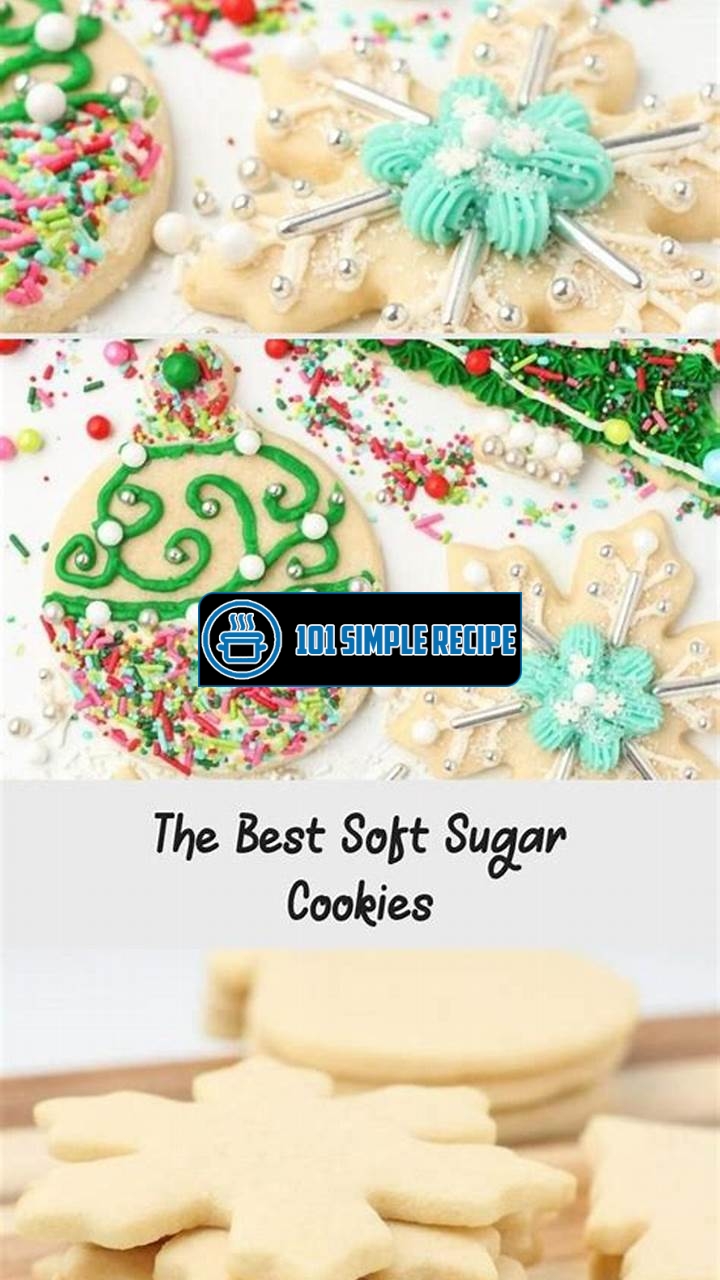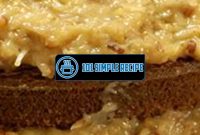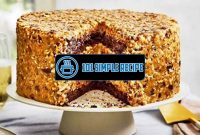If you’re a fan of delicious baked treats and enjoy getting creative in the kitchen, then you’re in for a sweet and chewy delight with these Soft and Chewy Sugar Cookies for Decorating. Whether you’re looking to unleash your inner artist and decorate these cookies with colorful icing and sprinkles or simply want to savor their melt-in-your-mouth goodness, this recipe is sure to become a staple in your baking repertoire. With a perfect balance of sweetness and chewiness, these cookies are versatile enough to be enjoyed on their own or as a canvas for your artistic endeavors. So grab your apron and prepare to embark on a baking adventure that will leave you with a plate full of delectable, picture-perfect cookies. ✨

The History of Sugar Cookies
Sugar cookies have a rich and fascinating history that dates back centuries. These delectable treats have evolved over time and hold a special place in various cultures around the world. Let’s delve into the origins and significance of sugar cookies.
Ancient Origins of Sugar Cookies
The roots of sugar cookies can be traced back to ancient times. Some historians believe that the concept of sweetening bread dates back to the Egyptian civilization, where honey was used as a natural sweetener. As trade routes expanded, sugar became more accessible, leading to the creation of early sugar cookies.
In medieval Europe, sugar remained a luxury item and was mainly reserved for the rich. However, during festive occasions such as Christmas, sugar cookies were baked and shaped into intricate designs. These cookies symbolized joy and celebration, becoming a beloved tradition that continues to this day.
The Dutch are often credited with introducing sugar cookies to America. In the 17th century, Dutch immigrants brought their baking traditions to the New World, including speculaas cookies, which were spiced sugar cookies. Over time, these recipes were adapted and transformed into the soft and chewy sugar cookies we know today.
Sugar Cookies Around the World
Sugar cookies have spread across the globe, adapting to the diverse palates and cultures of different regions. In the United Kingdom, traditional sugar cookies known as “biscuits” are often served with tea and enjoyed as a delightful snack.
In Sweden, “pepparkakor” sugar cookies are a beloved Christmas tradition. These thin and crispy treats are often shaped into gingerbread men and intricately decorated with icing.
Germany is famous for its “Pfeffernüsse” sugar cookies, which are spiced with an assortment of flavorful ingredients like cinnamon, nutmeg, and cloves. These cookies are popular during the holiday season.
Symbolism and Traditions with Sugar Cookies
Sugar cookies hold symbolic meaning in many cultures and traditions. In some countries, sugar cookies are baked in the shape of religious symbols or figures during religious festivals and celebrations.
Furthermore, sugar cookies are commonly used for decorating and personalizing. They offer a blank canvas for artistic expression, allowing individuals to showcase their creativity. Whether it’s a birthday party, wedding, or holiday gathering, sugar cookies add a touch of sweetness and personalization to any occasion.
In modern times, sugar cookies have become an essential part of popular culture. From cookie decorating competitions on television to social media trends, these cookies continue to captivate people’s imaginations and taste buds.
In conclusion, the history of sugar cookies is a testament to their universal appeal. These soft and chewy treats have evolved over time, reflecting the traditions and tastes of different cultures. Whether they are enjoyed as a festive delicacy or used as a form of artistic expression, sugar cookies continue to bring joy and sweetness to people around the world.
Key Ingredients for Perfect Sugar Cookies
When it comes to creating soft and chewy sugar cookies that are ready for decorating, there are a few key ingredients that you need to have. These essential elements work together to give your cookies the perfect texture and taste. In this article, we will explore the role of butter in sugar cookies, selecting the right flour, and enhancing flavor with vanilla extract.
The Role of Butter in Sugar Cookies
Butter plays a crucial role in determining the texture and flavor of your sugar cookies. It provides moisture and richness, resulting in a soft and chewy cookie. When selecting butter for your recipe, it is important to choose unsalted butter. This allows you to have control over the amount of salt in your cookies and avoid any overpowering flavors.
Tip: Make sure the butter is at room temperature before creaming it with the sugar. This will ensure proper incorporation and a smooth dough.
Selecting the Right Flour for Sugar Cookies
The type of flour you use can greatly affect the texture of your sugar cookies. All-purpose flour is commonly used for sugar cookies, as it strikes a balance between tenderness and structure. However, for an even softer and more chewy cookie, you can use a combination of all-purpose flour and cake flour. Cake flour has less protein, resulting in a more delicate crumb.
Tip: For every cup of all-purpose flour, you can replace two tablespoons of it with two tablespoons of cornstarch. This will yield a tender and melt-in-your-mouth texture.
Additionally, sifting your flour before adding it to the dough can prevent any lumps and create a smoother cookie.
Enhancing Flavor with Vanilla Extract
Vanilla extract is a classic flavoring for sugar cookies. Its sweet and aromatic profile complements the buttery base and adds depth to the overall taste. When using vanilla extract, it is recommended to use pure vanilla extract rather than imitation vanilla. Pure vanilla extract is made from real vanilla beans and has a more authentic flavor.
Tip: If you want to experiment with different flavors, you can substitute a portion of the vanilla extract with other extracts such as almond or lemon. This will give your sugar cookies a unique twist.
By understanding the importance of these key ingredients, you can create soft and chewy sugar cookies that are perfect for decorating. Remember to use quality ingredients and follow the recipe closely to achieve the best results. Happy baking!
Mastering the Perfect Texture and Thickness
When it comes to creating soft and chewy sugar cookies for decorating, achieving the ideal texture and thickness is crucial. These cookies serve as the perfect canvas for intricate designs and vibrant icing. In order to master this essential aspect of cookie baking, you need to learn some tips and techniques that will help you achieve perfection every time.
The Science Behind Chewiness
Understanding the science behind chewiness is the first step towards creating soft and chewy sugar cookies. The key ingredient responsible for this desirable texture is moisture. By adding enough moisture to the dough, the cookies will turn out tender and chewy. This can be achieved by using ingredients like brown sugar, corn syrup, or even adding a touch of molasses. The moisture in these ingredients helps to prevent the cookies from drying out during the baking process, resulting in a soft, chewy texture that melts in your mouth.
Rolling and Cutting the Cookie Dough
The next important step in creating the perfect texture and thickness for your sugar cookies is rolling and cutting the dough. When rolling out the dough, it is important to use a rolling pin to achieve an even thickness. Using a thickness guide or rolling pin rings can help you achieve consistent results.
When cutting the cookie dough into shapes, it is essential to use the right technique and tools. Make sure to dust the surface and cookie cutters with flour to prevent the dough from sticking. Additionally, avoid twisting the cookie cutter while cutting the dough as this can cause the edges to become misshapen. Instead, gently press down and lift the cutter straight up to maintain the shape and integrity of the dough.
Baking Time and Temperature
The final step in achieving the perfect texture and thickness for your sugar cookies is baking them at the right time and temperature. It is recommended to preheat your oven to the specified temperature in the recipe, usually around 350°F (180°C). This ensures that the cookies bake evenly and maintain their softness.
For soft and chewy sugar cookies, it is important to slightly underbake them. This means that you should remove the cookies from the oven when they are just set around the edges and still soft in the center. The residual heat will continue to cook the cookies as they cool down, resulting in a soft and chewy texture.
In summary, achieving the ideal texture and thickness for soft and chewy sugar cookies involves understanding the science behind chewiness, rolling and cutting the dough with precision, and baking them at the right time and temperature. By following these tips and techniques, you can create cookies that are not only delicious but also perfect for decorating. So go ahead and start experimenting in your kitchen to master the art of soft and chewy sugar cookies!
Old Fashioned Butter Cookie Recipe
Decorating Techniques for Impressive Designs
Unlock the secrets to creating visually stunning sugar cookie designs that are sure to impress. Whether you’re a beginner or an experienced baker, these decorating techniques will take your soft and chewy sugar cookies to the next level.
Working with Royal Icing
Royal icing is the key to achieving beautiful and intricate designs on sugar cookies. It has a smooth texture that hardens when it dries, making it perfect for creating crisp lines and intricate details. To make royal icing, you’ll need confectioners’ sugar, egg whites, and a touch of lemon juice or cream of tartar. Beat the ingredients together until they form stiff peaks, then transfer the icing to a piping bag fitted with a small round tip.
Royal icing can be colored using gel food coloring, which produces vibrant hues without altering the consistency of the icing. Divide the icing into separate bowls and add a few drops of coloring to each one. Mix well until the desired shade is achieved. Remember, a little goes a long way, so start with a small amount of coloring and add more if needed.
Note: Avoid using liquid food coloring, as it can thin out the icing and make it difficult to achieve precise designs.
To achieve uniform flooding, thin out a portion of the royal icing with water until it reaches a slightly runny consistency. Transfer it to a squeeze bottle or a piping bag with a larger round tip. This technique is called flooding, and it allows you to fill larger areas of the cookie with a smooth layer of icing. Start by outlining the area you want to flood with a thicker royal icing, then fill it in by piping the thinner icing back and forth until the area is covered.
Pro tip: To prevent air bubbles from forming in the icing, gently tap the cookie on a flat surface after flooding and use a toothpick to pop any bubbles that appear.
Piping and Flooding Techniques
Piping allows for more intricate and detailed designs on your sugar cookies. Attach a piping bag with a small round tip to your royal icing and carefully pipe lines, dots, or other shapes onto the cookies. You can experiment with different piping tips to achieve various effects, such as star or leaf shapes.
Flooding, as mentioned before, is the technique of filling larger areas with a smooth layer of icing. It’s ideal for creating a solid background or base for more intricate designs. After piping an outline with thicker icing, use a squeeze bottle or piping bag with a larger round tip to flood the area with thinner royal icing.
- Pro tip: To create dimension and depth in your designs, try layering different colors of flooded icing. Start with the lighter color and let it dry completely before adding the second layer.
Using Edible Decorations and Food Coloring
In addition to royal icing techniques, you can enhance your sugar cookie designs with edible decorations and food coloring. Sprinkles, sanding sugar, and edible pearls are fantastic options for adding texture and visual interest to your cookies. Apply them while the icing is still wet so that they adhere properly.
Food coloring can also be used to create unique and eye-catching designs. Divide your royal icing into separate bowls, mix in different food coloring shades, and use a toothpick or small brush to create intricate patterns and details on the cookies.
Remember: Allow your decorated cookies to dry completely before stacking or packaging to avoid smudging or damaging the designs.
In conclusion, mastering these decorating techniques will transform your soft and chewy sugar cookies into stunning works of art. With a little practice and creativity, you’ll be able to impress your friends and family with your beautifully decorated treats.
Storage and Preservation Tips
When it comes to enjoying your beautifully decorated sugar cookies for an extended period, proper storage and preservation techniques are crucial. You want to ensure that your cookies stay soft and chewy, preserving their delightful taste and texture. This article will guide you through the best practices to follow for long-lasting enjoyment of your sugar cookies.
Proper Packaging and Sealing
Proper packaging is essential to maintain the freshness of your sugar cookies. After allowing your icing to dry completely, it’s important to store the cookies in an airtight container. This will prevent any moisture from getting in and making the cookies soggy. Choose a container that provides enough space without allowing the cookies to move around too much. You can line it with parchment paper or wax paper to separate the layers and prevent sticking. This method will keep your sugar cookies fresh and ready for decorating.
Another effective way to preserve the softness of your cookies is by using food-grade cellophane bags. Place each cookie in an individual bag and seal it tightly. This not only protects the cookies from air but also makes them convenient to grab and enjoy whenever you please. Moreover, you can add a decorative ribbon or tie to give them an extra-special touch. Whether you’re storing the entire batch or packaging cookies as gifts, proper packaging and sealing techniques are essential for maintaining their freshness.
Freezing and Thawing Methods
If you want to extend the shelf life of your sugar cookies even further, freezing is a great option. Freezing your cookies not only preserves their taste and texture, but it also allows you to have them readily available for future decorating sessions or special occasions.
To freeze your sugar cookies, follow these simple steps:
- Cooling: Allow the freshly baked cookies to cool completely.
- Layering: Place your cookies in a single layer in a freezer-safe container or airtight bag. If you need to stack the cookies, separate each layer with parchment or wax paper.
- Sealing: Make sure to seal the container or bag tightly to prevent freezer burn and maintain the cookies’ freshness.
- Labeling: It’s important to label the container or bag with the date of freezing to keep track of how long they have been stored.
When it’s time to enjoy your frozen cookies, follow these thawing methods:
- Room Temperature Thawing: Remove the cookies from the freezer and allow them to thaw at room temperature for a couple of hours. This method helps retain their softness and chewiness.
- Oven Thawing: If you’re short on time, preheat your oven to a low temperature (around 200°F or 95°C), place the frozen cookies on a baking sheet, and warm them up for a few minutes until they reach the desired temperature. This method allows you to enjoy warm and freshly baked cookies quickly.
Refreshing Stale Sugar Cookies
Even with proper storage, sugar cookies can sometimes become stale over time. But don’t worry, there are simple tricks to refresh them and bring back their delightful texture.
If your sugar cookies have lost their softness, you can revive them using a piece of bread. Place the stale cookies in an airtight container with a slice of fresh bread. The cookies will absorb the moisture from the bread, making them soft and chewy again. Leave them sealed together overnight, and you’ll wake up to perfectly refreshed cookies in the morning!
Note: Another method to freshen your cookies is by placing them in a microwave for a few seconds, if they don’t have decorations that may melt.
With these storage and preservation tips, you no longer have to worry about your sugar cookies losing their softness and flavor. Properly packaging and sealing, freezing and thawing, and refreshing stale cookies will ensure that your decorative treats can be enjoyed for a longer period, bringing joy to both you and your loved ones. Happy decorating!
Thank you for reading our article on soft and chewy sugar cookies for decorating! We hope you enjoyed learning about this delicious treat and feel inspired to try making them yourself. Whether you’re a professional baker or just starting out, these cookies are sure to impress. Don’t forget to bookmark our page, so you can easily find this recipe again later!
Frequently Asked Questions
Here are some commonly asked questions about soft and chewy sugar cookies for decorating:
| No. | Questions | Answers |
|---|---|---|
| 1. | How long do these cookies stay fresh? | These cookies can be stored in an airtight container at room temperature for up to one week. |
| 2. | Can I freeze these cookies? | Yes, you can freeze these cookies for up to three months. Just make sure to thaw them before decorating. |
| 3. | Can I use different cookie cutters? | Absolutely! Feel free to get creative with different shapes and sizes of cookie cutters. |
| 4. | What kind of icing should I use to decorate these cookies? | Royal icing works best for decorating these cookies. It dries hard and is perfect for intricate designs. |
| 5. | Can I add food coloring to the dough? | Yes, you can add food coloring to the dough to create different colored cookies. Just make sure to use gel food coloring for best results. |
| 6. | Can I use butter instead of margarine in this recipe? | Yes, you can substitute butter for margarine in this recipe. The cookies will have a slightly different texture, but they will still be delicious. |
Closing Thoughts
We hope you have a great time making and decorating these soft and chewy sugar cookies. They are perfect for any occasion, whether it’s a holiday, birthday party, or just a fun baking project. Remember to have fun and let your creativity shine as you decorate these tasty treats. Thank you for reading, and we can’t wait for you to visit again later!
Jump to Recipe
Soft and Chewy Sugar Cookies for Decorating

Learn how to make soft and chewy sugar cookies that are perfect for decorating. These delicious cookies are a blank canvas for your creativity and can be customized for any occasion.
- 2 3/4 cups all-purpose flour
- 1 teaspoon baking soda
- 1/2 teaspoon baking powder
- 1 cup unsalted butter (softened)
- 1 1/2 cups white sugar
- 1 egg
- 1 teaspoon vanilla extract
- sprinkles or icing for decoration
- Preheat your oven to 375 degrees F (190 degrees C). In a small bowl, whisk together the flour, baking soda, and baking powder. Set aside.
- In a large bowl, cream together the softened butter and white sugar until light and fluffy. Beat in the egg and vanilla extract.
- Gradually add the dry ingredients to the butter mixture, mixing until just combined. Do not overmix.
- Roll the dough into 1-inch balls and place them on a baking sheet. Flatten each ball with the bottom of a glass dipped in sugar.
- Bake for 8 to 10 minutes, or until lightly golden brown around the edges. Let the cookies cool on the baking sheet for 5 minutes, then transfer to a wire rack to cool completely.
- Once the cookies are completely cooled, decorate them with sprinkles or icing. Let the decorations set before serving.






